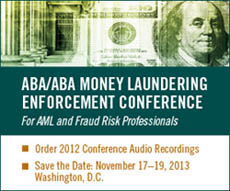Top civil money penalty tier hiked by Fed and OCC
Quadrennial review sees increase for worst offenses
- |
- Written by Nancy Derr-Castiglione
- |
- Comments: DISQUS_COMMENTS

This blog falls under the category of "news we hope you'll never need to use." Civil money penalties have been updated by the regulators.
Every four years the agencies are required by the Federal Civil Penalties Inflation Adjustment Act of 1990 to review the penalty amounts that they can assess for violations and adjust them for inflation. The last time they did that was in 2008.
Both the Comptroller's Office and the Federal Reserve Board have recently updated their schedules of civil money penalties for violations of the various laws and regulations under their jurisdictions for national banks, savings associations, and state member banks. (A word about FDIC later on.)
Civil money penalties are the maximum amounts per violation that the regulators can impose for violations of laws and regulations--per day. They can, and do, negotiate lesser amounts. There is a considerable amount of discretion in setting the amount of the penalty up to the maximums established.
Some of the penalties have increased. Some have stayed the same. As expected, none have decreased.
The regulators are working with specific formulas and rounding rules for calculating the increases or non-increases. There is no provision in the calculations for decreasing the penalties.
Increase in highest tier
For most CMPs, there are three tiers of violations.
- • The first tier covers inadvertent violations.
- • The second tier covers a pattern of misconduct that causes more than minimal loss to the institution or constitutes a reckless unsafe or unsound practice.
- • The third tier covers knowingly committed misconduct and generally involves a substantial loss to the institution or a substantial pecuniary gain to the violator.
For most of the laws subject to CMPs, only the top tier saw an increase this time. The top tier penalty for most of the CMP categories increased from $1,375,000 per day per violation to $1,425,000 per day per violation. That's a 3.2% increase. Tier one, the lowest tier, remained at $7,500 per day per violation, and tier two remained at $37,500 per day per violation.
Penalties unchanged
Some penalties did not change. The maximum CMP for violations of the Minimum Security Devices statute remains at $110 per day per violation. (This penalty hasn't changed since 1997.)
The penalty for violations of law prohibiting depository institutions from offering NOW accounts to depositors other than individuals and other eligible nonprofits or government entities has also held steadfast at $1,100 per day per violation.
Flood insurance penalties
Penalties for flood insurance compliance violations are not part of the quadrennial CMP exercise of the regulators. The Biggert-Waters Flood Insurance Reform Act of 2012 that became law this past summer increased the penalties for violations of the flood insurance regulations from $350 per violation to $2,000 per violation. The $100,000 maximum annual penalty was also eliminated by that statute.
Effective dates
The Comptroller's new penalty structure for national banks and savings associations took effect Dec. 6, 2012. The Fed's took effect for state member banks and bank holding companies Nov. 16, 2012.
For both, the new penalties would apply to violations that occur after the effective dates. Violations that occur prior to the effective dates would be subject to the previously effective penalties.
What about FDIC?
The FDIC hasn't yet announced its CMP penalty structure for 2012. But, it will likely be similar to those of the OCC and Federal Reserve Board.
Tagged under Compliance, Risk Management, Blogs, Common Sense Compliance, Compliance Management, Compliance/Regulatory,














